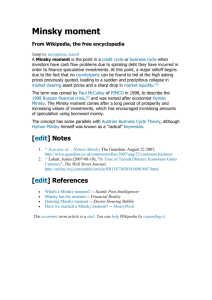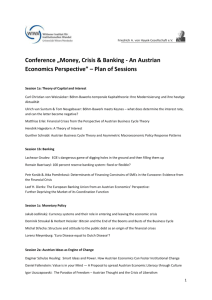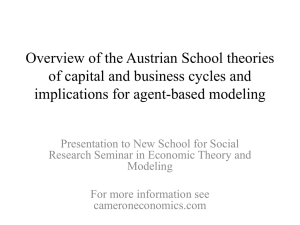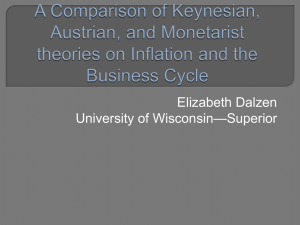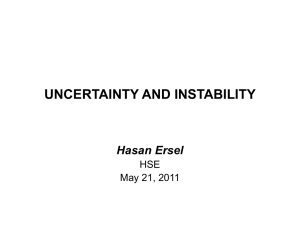Folie 1
advertisement
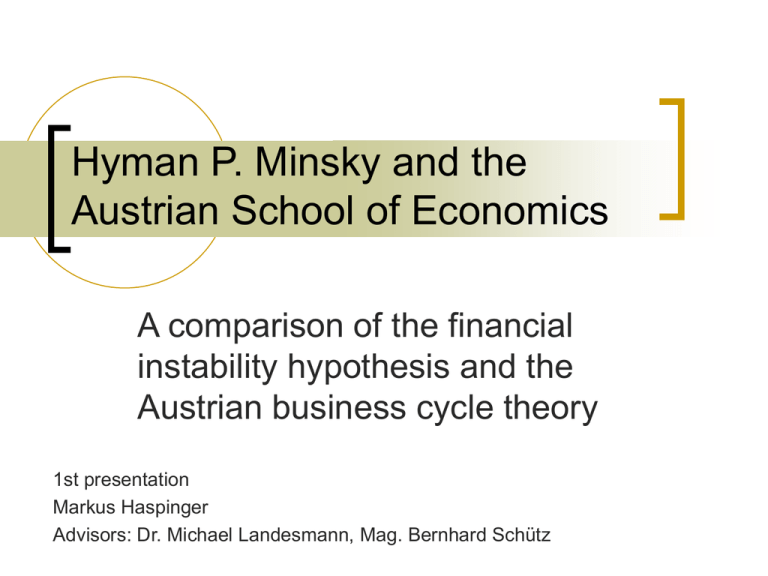
Hyman P. Minsky and the Austrian School of Economics A comparison of the financial instability hypothesis and the Austrian business cycle theory 1st presentation Markus Haspinger Advisors: Dr. Michael Landesmann, Mag. Bernhard Schütz Introduction I Major Schools of Economics Source: http://socialdemocracy21stcentury.blogspot.co.at/2011/01/overview-of-major-schools-of-economics.html 1 Introduction II Post-Keynesian Economics Importance of (historical) time Emphasizes risk/uncertainty, irrationality of economic actors and inherent instability of financial sector Favors fiscal policy Austrian School of Economics Highlights the self-organizing power of markets Methodological individualism, disdain for mathematical modeling and econometrics Rejects government intervention 2 Motivation Two monetary overinvestment theories of ideologically opposite schools of thought Financial Instability Hypothesis (Hyman P. Minsky) Austrian Business Cycle Theory (Ludwig Mises, Friedrich Hayek) Both (re)gained attention during the financial crisis of 2008 Source: Google Trends 3 Financial Instability Hypothesis Theory about debt accumulation and credit-driven cycles Stability is destabilizing: „The tendency to transform doing well into a speculative investment boom is the basic instability in a capitalist economy.” –Minsky (1977), p.13 Over prolonged periods of stability, investors take on more and more risk until lending exceeds what borrowers can pay off from their future cashflows To meet repayment demands, over-indebted investors have to sell even less-speculative positions As a result, asset prices spiral downwards and a severe demand for cash comes about 4 Austrian Business Cycle Theory Focus on investment and interest rate Two kinds of interest rates: Natural rate of interest (reflects return on investment) Market rate of interest (reflects borrowing costs by banks) Low interest rates encourage borrowing from banking system An unsustainable credit-fueled investment boom comes about Boom causes misallocation of capital resources through widespread overinvestment When credit creation cannot be sustained (market rate increases or natural rate falls), boom turns into bust 5 Research Questions I In which respects are the financial instability hypothesis and the Austrian business cycle theory similar? How do they differ? Emphasize role of banking and financial markets Boom-bust cycle driven by credit market and expectations Major differences especially in the understanding of the role of government … Are there any common roots? Schumpeter Wicksell – Keynes … 6 Research Questions II How much explanatory power have these theories with regard to the financial crisis of 2008 (USA)? Investigating the FED‘s monetary policy Development of money supply, credit and debt Change of inflation and saving rates Trends in capital good prices (housing) and stock prices Changes in the structure of production … 7 Empirical Approach I Natural rate of interest Long-term rate: 10Y US government bond interest rate Market rate of interest Effective Federal Funds rate 8 Empirical Approach II Lengthening of production structure 9 Empirical Approach III Prices of capital goods increase 10 Structure Description and critical appraisal of both theories and exploration of their intellectual roots Application on the financial crisis of 2008 (USA) Comparing them both theoretically and before the background of the financial crisis of 2008 Conclusion 11 Basic literature Hayek, Friedrich A. (1976), Geldtheorie und Konjunkturtheorie, Wolfgang Neugebauer: Salzburg. Minsky, Hyman P. (1977), The Financial Instability Hypothesis: an Interpretation of Keynes and Alternative to “Standard” Theory, Nebraska Journal of Economics and Business, Vol. 16, No 1, pp. 5-16. Minsky, Hyman P. (1992), The Financial Instability Hypothesis, The Jerome Levy Economics Institute of Bard College, Working Paper No. 74. Mises, Ludwig (1924), Theorie des Geldes und der Umlaufsmittel, Duncker & Humblot: München. 12
